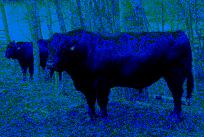| | Transmission | Clinical presentation | Diagnosis | Prevention | Treatment
.

Trichomoniasis is still confirmed in bulls from some farms in Alberta. Infected bulls are often the main source of introducing the infection into uninfected herds. Bulls remain chronically infected and hence carry the infection from one year to the next. Introducing infected open cows will also introduce the infection to an uninfected herd. Impact on pregnancy rate and calf crop in operations that use natural service in their breeding programs can be devastating if the infection is introduced to a na´ve herd.
We are therefore recommending that in herds where a potential for introduction of the disease exists, testing of bulls and prevention measures mentioned below should be undertaken prior to the breeding season.
Transmission
The parasite Tritrichomonas fetus is transmitted when an infected bull breeds with a susceptible heifer or cow. Infected cows can transmit the disease to virgin uninfected bulls during breeding. Although young bulls (<3 years) may clear the infection, infected bulls become long-term carriers and thereby carry the infection from one breeding season to the next. Some infected cows can deliver a normal calf; fortunately such carrier cows are very rare. Bulls from multiple sources on community pastures, sharing of bulls by multiple herds and purchasing and using untested older bulls in emergency situations during the breeding season pose the greatest threat of contracting the disease.
Clinical Presentation
The parasite usually causes death of the developing foetus between 18-70 days of pregnancy with some cows developing post-coital pyometra. Some cows may abort as late as five months into pregnancy. Often the first indication of a disease problem in a herd is when a producer notices the cows he thought were pregnant resume cycling towards the end of the breeding period. When breeding period is not closely supervised, the first indication of a problem is often an increased number of cows that are cycling and not pregnant at the end of the breeding period. In operations with the infection, majority of calvings are in the latter half of the calving season. In contrast, in herds without infection, 80% of the cows will calve within the first two heat cycles of the calving period provided that the cows are in good body condition and other diseases that affect reproduction are not present
Diagnosis
Testing herd bulls rather than cows for trichomoniasis is more rewarding and economical because there are fewer bulls to test and the disease is self-limiting in cows. Collecting, culturing and laboratory examination of the smegma from bulls is the diagnostic technique for field use. The chance of detecting the parasite is increased if the bull is separated from cows for at least 2 weeks before testing.
PCR testing of smegma, a recently developed and tested method, is now used by many diagnostic laboratories. Smegma is aspirated from the prepucial fornix area using a bovine uterine infusion pipette attached to a 12 cc syringe. Slight hemorrhage in aspirated smegma is acceptable for an effective sample collection. The collected sample should be placed immediately in tubes/pouches (In PouchR) containing culture medium that is at 20-25oC. These tubes/pouches should be stored in container away from direct sunlight and during transport to the laboratory, these samples should not be allowed to cool to single digit temperatures or freeze.
The sensitivity for three samples collected and tested at weekly intervals of either culture or PCR technique used individually was 80% and 85% respectively and a combination of both techniques had a sensitivity of 87.5%. The specificity for both techniques used either individually or in combination on single and multiple samples was greater than 95%
Prevention
Preventing introduction of this disease in the herd should be the main emphasis in any management plan. Prevention measures are effective in closed herds and are important in reducing the risk of acquiring and spreading the disease in community pastures. Many producers already conduct some of the following measures:
- Only use virgin bulls and heifers as replacements; use as many home-raised heifers as possible.
- Only buy confirmed pregnant heifers if outside replacements are needed.
- Maintain a limited tight breeding season.
- Keep the average bull age as young as possible.
- Test all mature bulls for trichomoniasis at least three times at weekly intervals before introducing them into your herd.
- For community pastures test all bulls for trichomoniasis at least three times before beginning of the breeding season.
- Only allow cows with their calves at foot or virgin heifers in the grazing reserve to eliminate the risk of introducing infected cows.
- Perform breeding soundness exams of all bulls before turnout.
- Monitor the breeding period to detect signs of excessive repeat breeding.
- Control other reproductive diseases like campylobacteriosis with appropriate vaccinations
- Perform breeding soundness exam of all bulls before turnout.
- Cull open cows at pregnancy check and test cows that have recently aborted.
- Do not purchase open cows from auction market.
- Avoid using and or sharing bulls from unknown herd history.
- Consider implementing an artificial insemination program in the herd.
- Maintain proper fencing of pastures to avoid mixing of animals from herds with unknown status.
Vaccinating cows in the herd is an option however it is expensive, not 100% efficacious and the vaccine is not available in Canada.
Treatment
Currently there are no approved treatments for trichomoniasis in either the bull or cow.
Dr. Jagdish Patel, Surveillance Veterinarian, Animal Health and Assurance Division, Edmonton, AB
For further information please contact Dr. Jagdish Patel at 780-644-5093. |
|